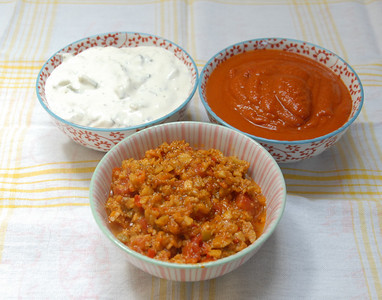With Independence Day and a long weekend of picnics and BBQs just around the corner, it seems like the perfect time to talk about condiments. Whether sweet, sour, spicy or a tad salty, these toppings have added flavor and flare to food for centuries. While ketchup, mustard and mayonnaise still reign supreme, there are plenty of unusual dressings to spice up your summer meals.

Love some heat with your meat? Spoon on the fiery, North African condiment harissa. This crimson sauce consists of hot chilies, garlic, cumin, caraway seeds and sea salt. As an indicator of just how spicy it can be, commercially produced harissa comes in cans decorated with erupting volcanoes.
Usually harissa accompanies couscous. In Tunisia, though, it’s used as a sandwich spread. It also gives an extra kick to vegetables and seafood. Some cooks add a little yogurt to their harissa and offer it as a dip.
If harissa sounds too searing, try the milder North African chermoula. It starts with a base of cilantro, parsley, garlic, lemon juice and olive oil but can go on to include ginger, red pepper oil, saffron, paprika, cayenne and even vinegar. Every country and cook in North Africa seems to have a unique chermoula recipe.
Unlike the multipurpose harissa, chermoula primarily serves one role – to dress fish. It acts as a marinade for firm, white-fleshed fish and as a cold sauce for fried fish and shellfish.
If you like saltiness, slather on some tapenade. Based on the French word for “capers,” tapenade is a thick, dark paste of pureed capers, black olives, anchovies and olive oil. Variations exist, including tapenades with garlic, lemon juice, mustard, green olives and/or tuna.
In Southern France cooks daub tapenade over crisp baguettes and serve it as an hors d’oeuvre. Elsewhere it flavors seared fish steaks, grilled vegetables, crackers or warm pita bread. It also acts as a stuffing for oven-roasted tomatoes and works as a savory spread for grilled fish sandwiches.
Prefer to cool off your palate? Spread refreshing tzatziki over your grilled lamb, chicken, vegetables or fish. A staple of Greek cuisine, tzatziki couldn’t be simpler to make. Just whisk together strained, plain yogurt, chopped cucumber, diced garlic and minced, fresh mint.
In Greece this creamy sauce tops such dishes as gyros and souvlaki. It can likewise be used a dip for vegetables. Paired with pita bread, it becomes a simple appetizer.
CHERMOULA
Makes roughly 1/3 cup
6 cloves garlic, peeled and quartered
1 ½ teaspoon crushed chili pepper
1 teaspoon ground cumin
1 teaspoon salt
½ teaspoon paprika
generous handful of cilantro, washed and stems removed
handful of parsley, washed and stems removed
juice of 1 ½ lemons
2 ½ tablespoons olive oil
ground black pepper to taste
Using a food processor, pulse all the ingredients together until they have formed a paste. Alternately, you can use a mortar and pestle and combine the garlic with the chili and black pepper, cumin, paprika, cilantro and parsley. Add the oil and lemon juice right before using.
HARISSA
Makes 1/3 cup
warm water, enough to soak the chili peppers
12 medium-sized, dried ancho chili peppers
5 cloves garlic, peeled
1 teaspoon cumin seeds
1 teaspoon coriander seeds
1 tablespoon hot pepper paste
½ teaspoon sea salt
2 tablespoons olive oil
Remove the tops and seeds of peppers and place them in a bowl with enough warm water to cover them. Allow them to soak for about 45 minutes or until they are soft.
Meanwhile place the cumin and coriander seeds in frying pan and toast the over medium heat until golden and aromatic. Remove from the heat, cool and then grind in either a spice or coffee grinder or pulverize with a pestle and mortar.
Drain the chilies and place them in the bowl of a food processor or blender. Add the garlic and pulse until they have become a crunchy paste. Add the ground spices, hot pepper paste, olive oil, salt and pulse twice. Remove the harissa from the bowl and place in an airtight container in the refrigerator until ready to use.